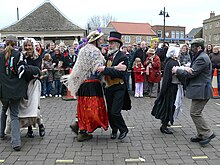Molly dance
This article needs additional citations for verification. (December 2013) |

Molly dancing is a form of English Morris dance, traditionally done by out-of-work ploughboys in midwinter in the 19th century.
History[edit]
Molly dancing is a dance tradition from East Anglia, first attested in the 1820s. The first recorded use of the word "Molly" in relation to this tradition was in 1866.[1] The dance was performed on Boxing Day (26 December) and Plough Monday (the Monday after 6 January).[2] It died out during the early 1930s, the last dancers seen dancing in Little Downham near Ely, Cambridgeshire, in 1933.[3] The term molly itself was used since at least 1754 for 'a milksop, an effeminate man';[4] see also Molly house.
In 1930, Joseph Needham and Arthur Peck collected four molly dances from a dancer from Girton and a concertina player from Histon, near Cambridge.[5] In 1978, Russell Wortley and Cyril Papworth published four dances collected from the Comberton molly dancers.[6] William Palmer recorded a broom dance performed by the Little Downham dancers in 1933.[7]
Traditions[edit]
Molly dancing is most associated with Plough Monday, the first Monday after Epiphany. Tradition has it that as a way of filling the gap between Christmas and the start of the spring ploughing season, the ploughboys would tour around the village landowners, offering to dance for money. Those who refused would be penalised in various ways (see Trick or treat) including having a furrow ploughed across the offender's lawn.
The dancers, wishing to gain employment from those same landowners shortly afterwards, would attempt to conceal their identities by blacking their faces with soot and dressing up in a modified version of their Sunday best, typically black garments adorned with coloured scarves and other fripperies. It was originally an all-male tradition but with one of the members—the Molly—dressed up as a woman.

The modern tradition[edit]
Molly dancing was revived in the late 1970s, when teams began to once again perform the preserved dances.[2] In 1977 the Cambridge Morris Men resumed molly dancing to coincide with the revival of the Balsham Ploughboys. The Cambridge Men still dance Molly during the day on Plough Monday. The Morris dance revival of the 1970s led to the creation of many new sides, which nowadays usually involve both men and women.
In recent years, Molly dancing has enjoyed a popular revival both in East Anglia and the East Midlands, one of the best-known teams being the Ouse Washes Molly Dancers. The largest regular assemblage of Molly dancers is at the Whittlesea Straw Bear Festival, established 1980, which is held in Whittlesey, Cambridgeshire, every January.
Modern Molly dancing demonstrates the clearest distinction between "re-enactment of tradition" and "modern interpretation of tradition" of modern morris dancing. Elaine Bradtke wrote a PhD thesis on the inherent post-modernism of the Seven Champions, one of the first and best examples of modern Molly dance. Many other teams have developed Molly, inspired by the unhistorical but very effective military formations of Seven Champions (e.g. Ouse Washes, Gog Magog, Handsome Molly in New Jersey, Countess Isabella's Automata) whilst others have taken it in new directions, equally unhistorical but at their best equally effective in very different ways; e.g. Norwich Shitwitches (now renamed Kit Witches) and Pig Dyke Molly.
To this day Deptford Fowlers' Troop perform Molly dances, as well as parading Jack in the Green. They take their name from a century-old troop depicted in a photograph of 1906.
References[edit]
- ^ "Molly dancing". A Dictionary of English Folklore. Oxford University Press. 2003.
- ^ a b Bradtke 1999, p. 7.
- ^ W. Palmer, "Plough Monday 1933 at Little Downham" ED&S XXXVI, 1 (1974) 24-25
- ^ "Mollycoddle | Origin and meaning of mollycoddle by Online Etymology Dictionary".
- ^ Needham & Peck 1933, pp. 80–83.
- ^ Wortley & Papworth 1978, p. 58.
- ^ Palmer 1974, pp. 24–25.
- Bradtke, Elaine (1999). Truculent Rustics: Molly Dancing in East Anglia Before 1940. London: FLS Books.
- Needham, Joseph; Peck, Arthur L. (1933). "Molly Dancing in East Anglia". Journal of the English Folk Dance and Song Society. 1 (2). JSTOR 4521024.
- Palmer, William (1974). "Plough Monday 1933 at Little Downham". English Dance and Song. 36 (1).
- Wortley, Russell; Papworth, Cyril (1978). "Molly Dancing in South West Cambridgeshire". English Dance and Song.
